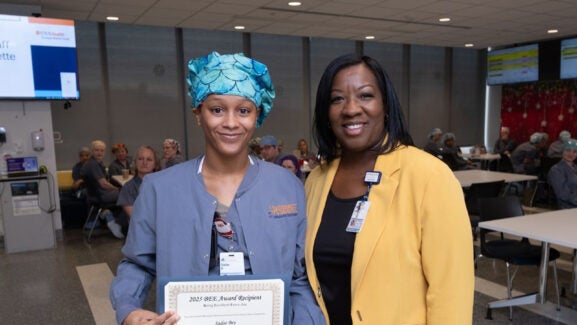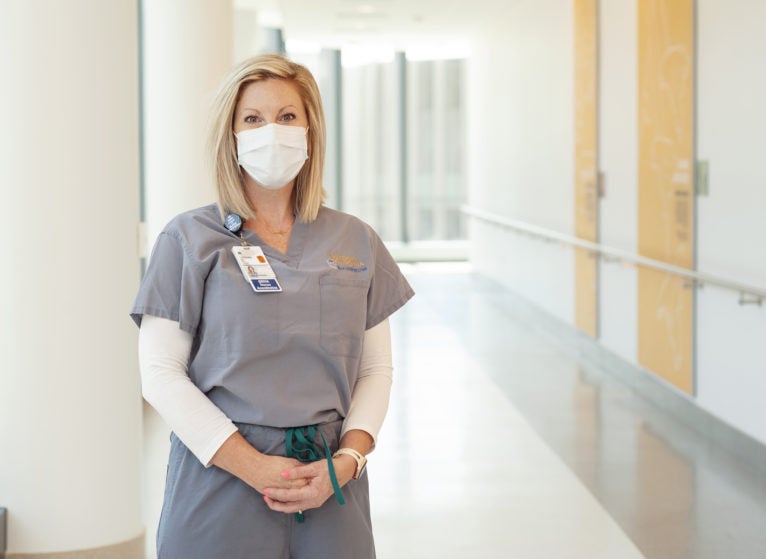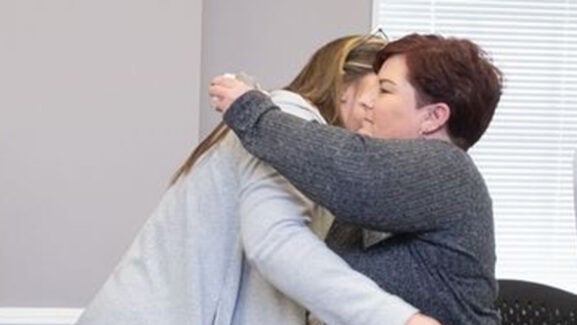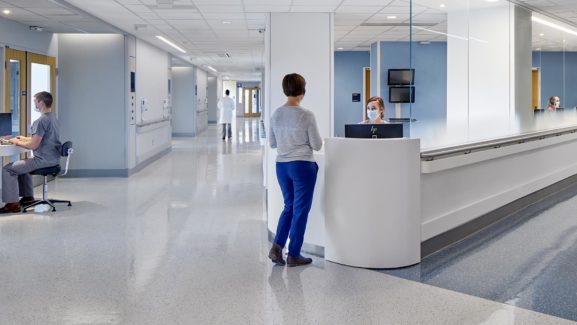

Lindsey Sites, CRNA Director
Continuing Education, QI, and Hugs: Spotlight on UVA’s CRNA Team
Certified registered nurse anesthetists, or CRNAs are advanced practice nurses who work in hospital operating rooms — administering anesthesia, comforting patients before and after surgery, and helping manage their pain. “We have the absolute best team of 65 CRNAs here at UVA,” says Lindsey Sites, CRNA, MSN, CRNA Director. “Our CRNAs teach, lecture, go on mission trips, serve on executive committees, recruit at national meetings… I could go on forever!” She laughs, but Sites is serious about her work, her team, and her patients.
Sites’ mother was a nurse at UVA, so she grew up in Charlottesville and attended UVA for her undergraduate studies. She returned to UVA after nursing school and has been a CRNA here for 15 years now, the last three as director. “Our CRNAs are dynamic, energetic and clinically strong, which makes them an absolute joy to lead every day,” says Sites.
Recently, Sites has been focused on two major projects. The first was to launch an education platform in conjunction with the anesthesia department and the Medical Simulation Center. Started four months ago as a way to provide consistent, high-level education to CRNAs beyond their weekly lectures, the simulation trainings have quickly become a “hot commodity.” Elizabeth Coles, a CRNA and trained simulation educator, organizes all of the sessions. “The sessions hone in on procedural skills by focusing on evidence-based practice, operating room and emergency scenarios,” says Sites. “They’ve been a great way to promote professional development and team engagement.”
The second project is related to hand hygiene rates. Towards the end of the pandemic, when infection rates were up across the hospital, Sites and Michael Miller, a PhD-candidate CRNA started working with Infection Control and Anesthesia leadership to identify how they were contributing to the problem. “We discovered that hand hygiene rates for all of Anesthesia were poor,” admits Sites. “We immediately started a quality improvement project around hand hygiene and workspace contamination.”
After much research, Sites and Miller found that Seattle Children’s Hospital had embarked on similar work in the early 2000’s. Using Seattle’s published findings as a guide, they developed a plan to designate a dedicated clean and dirty space, in addition to visual reminders and consistent sanitizer locations. “We knew that we needed to do something different to keep our patients safer,” says Sites.
Over the course of a recent two-day pilot, the hand-washing compliance rate in the control room remained low, while that in the experimental room jumped up to 86%. “We're really, really encouraged and excited,” says Sites. “It's just wonderful to see how well our interdepartmental model in the OR works. The whole team came together around a shared goal. It’s going to make a huge difference in how we take care of patients.”
Though Sites says “it's always about the patient,” she thinks a lot about employee retention, too. “We’re able to keep good people because we work to keep them happy,” she explains. Sites shares a few of her strategies for retaining good people:
- Be a good listener
- Create fair schedules, so everyone has a great work-life balance
- Help your employees have a fulfilling practice
- Be a servant leader, allowing your employees the time and space to work on their quality projects or go to the committee meetings that are meaningful to them
- Keep your door open and snacks in your office
- Give out lots of thanks-yous and hugs!
She says the nature of the work also helps with retention. “Anesthesia is unique because we’re so integrated throughout the hospital and our job varies day-to-day,” she explains. “As a CRNA, you might care for a really sick vascular patient one day, and the next day you’re putting someone to sleep for a colonoscopy. The variation is good for your practice, good for your brain, and good for job satisfaction.”
Latest News




Well-deserved spotlight!
Well done, Anesthesia team!! You all ROCK!
Proud to be a part of this team. L Sites, CRNA is an amazing leader. Thank you for all you do, not only for this team but for the process and environment that allows us to give the strong patient centered care we do.